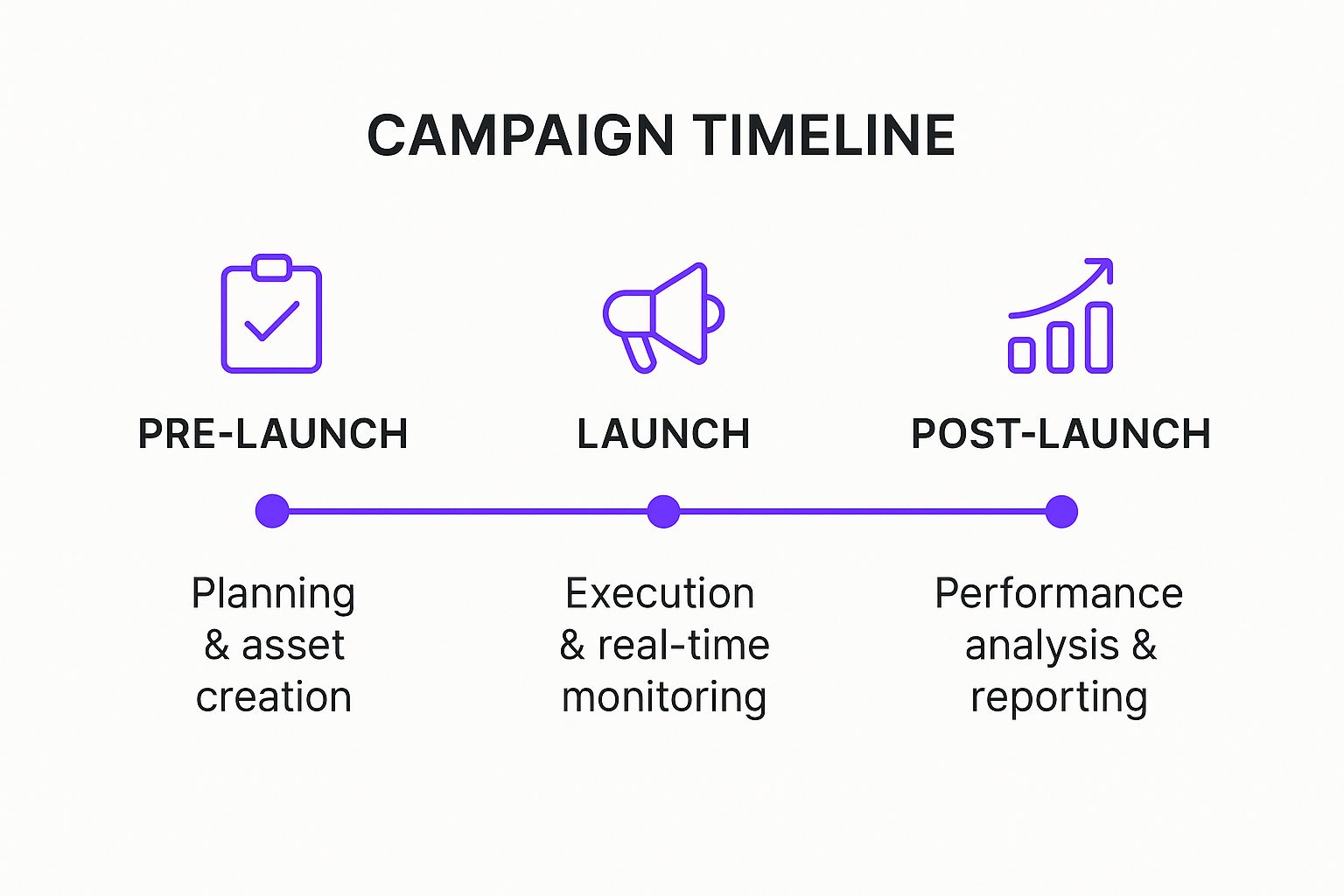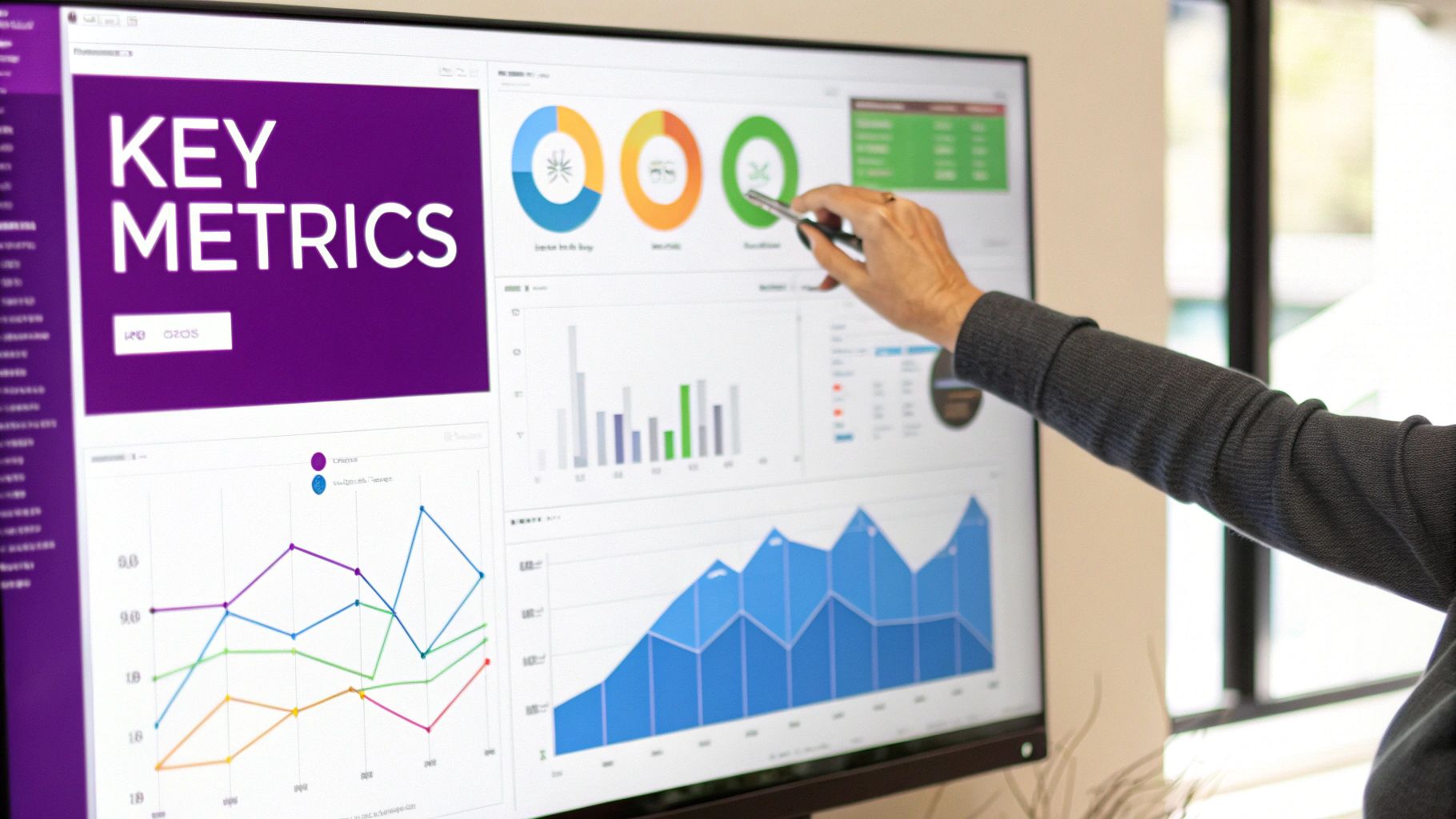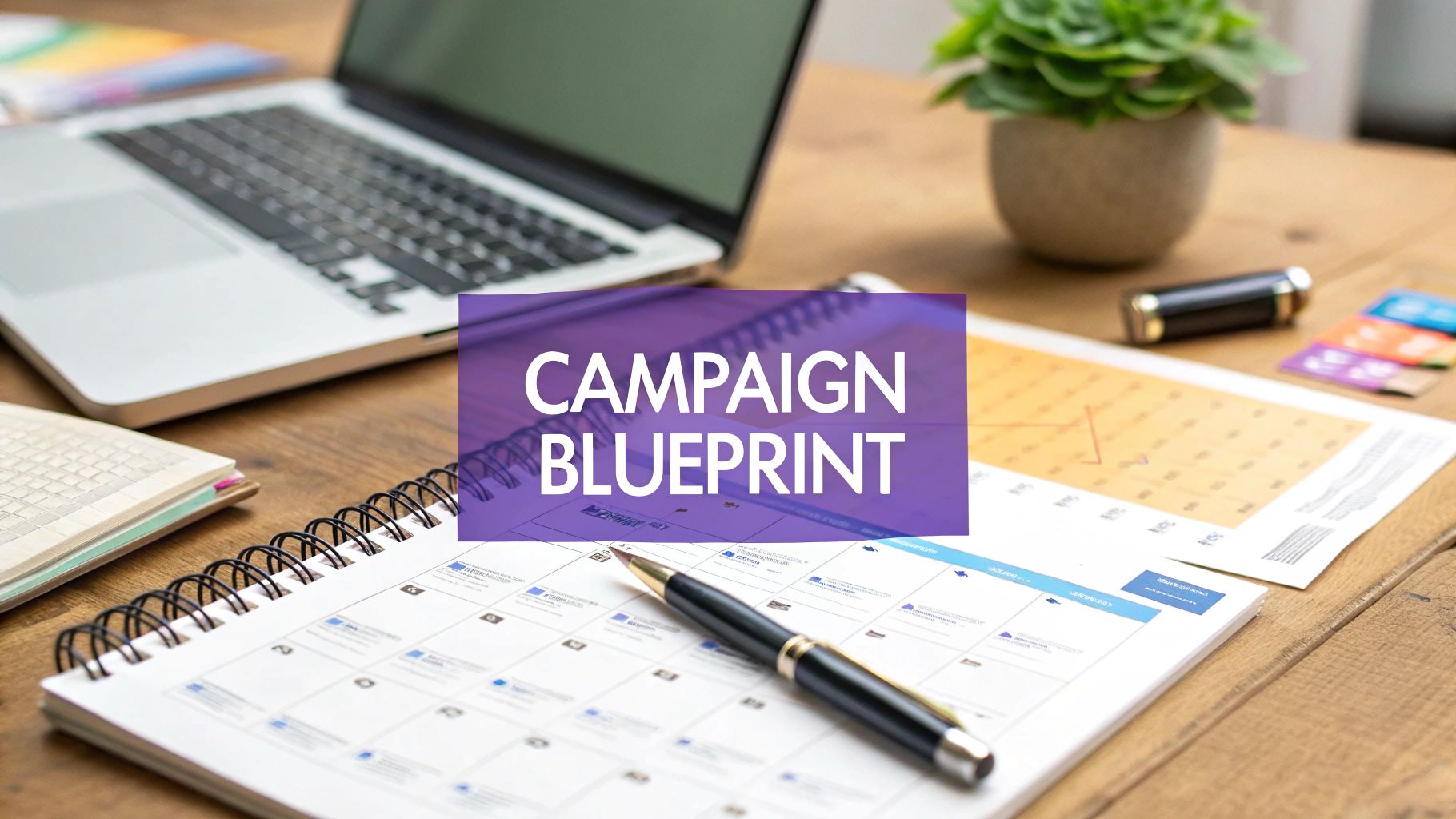Your Marketing Campaign Planning Template for Success
A solid marketing campaign template is the strategic playbook that guides your entire effort from start to finish. Think of it as your single source of truth—the one document that gets your entire team on the same page about goals, audience, budget, and how you’ll measure success. It’s what turns chaotic execution into a structured, repeatable process that actually works.
Why a Template Is Your Campaign's Secret Weapon
Ever tried running a marketing campaign without a plan? It feels a lot like assembling furniture without the instructions. You might get there eventually, but it’s going to be messy, stressful, and you’ll probably have a few crucial screws left over at the end.
A marketing campaign planning template is your blueprint for success. It transforms those reactive, last-minute scrambles into proactive, strategic execution. This structured document becomes the central nervous system for your entire campaign, ensuring everyone from the social media coordinator to the VP of Marketing is working from the same playbook.
Aligning Teams and Creating a Single Source of Truth
When teams are rowing in the same direction, you build unstoppable momentum. A shared planning document cuts through the noise and eliminates confusion by clearly outlining:
- Campaign Objectives: What’s the primary business goal this campaign is supposed to hit?
- Target Audience: Who are we actually talking to, and what do they care about?
- Key Messaging: What’s the core story we need to tell consistently across every single channel?
- Timeline and Milestones: Who is doing what, and by when?
This alignment prevents those costly (and embarrassing) miscommunications. I’ve seen it happen: without a template, the content team creates blog posts for one persona while the paid media team targets a completely different demographic. It’s a massive waste of both time and money.
If you're looking to tighten up this part of your process, our guide on building a comprehensive content marketing strategy template is a great place to start.
Here’s a great example of how a tool like Asana can visualize a campaign plan, breaking down complex projects into clear tasks and timelines.

This kind of visual approach makes it dead simple for any stakeholder to grasp the campaign’s structure, key phases, and upcoming deadlines at a glance.
Driving Efficiency and Proving ROI
A standardized process doesn't just keep your team organized; it directly impacts the bottom line. The strategic use of a template can dramatically boost your chances of success by harmonizing teams, budgets, and timelines.
In fact, companies that use a detailed marketing campaign planning template have reported a 20% increase in campaign ROI from better resource allocation and a 15% lift in audience engagement thanks to more targeted messaging.
A template forces you to tie every single marketing action back to a tangible business goal. This makes you justify your decisions with data, which makes it infinitely easier to prove your team's value and secure more budget for your next big idea.
At the end of the day, a template isn’t about creating restrictive paperwork. It’s about building a repeatable framework that helps your team pivot faster, spend smarter, and consistently deliver campaigns that actually move the needle.
It’s the difference between hoping for success and planning for it.
Defining Goals That Actually Drive Business Growth
Every legendary marketing campaign started with a clear destination. Let's be real—vague goals like "boost brand awareness" or "get more leads" might sound productive in a brainstorming session, but they fall apart under pressure.
These kinds of fuzzy aspirations make it impossible to know if you've actually won. Worse, they make it incredibly hard to prove your marketing team's value when the CFO comes knocking.
If you want real buy-in and a budget that isn't a rounding error, your goals have to connect directly to the company's bottom line. This means ditching the fluff and turning broad business needs into sharp, actionable targets. This is where the SMART framework saves the day. It’s a classic for a reason—it’s the simplest way to turn wishy-washy ideas into a concrete plan of attack.
A SMART goal is Specific, Measurable, Achievable, Relevant, and Time-bound. It’s the difference between saying "we want more website traffic" and declaring, "we will increase organic traffic to our key service pages by 15% in the next quarter." See? The second one gives you a clear target, a deadline, and a benchmark for success.
From Vague Ideas to Specific Targets
So how does this work in the real world?
Imagine your SaaS company wants to grab a bigger piece of the market. A knee-jerk marketing goal might be to "generate more demo requests." It's not a bad thought, but it leaves way too much room for interpretation.
Let's run it through the SMART framework and give it some teeth: "Generate 250 new marketing-qualified leads (MQLs) from the enterprise tech sector in Q3, with a target cost-per-lead (CPL) under $75."
Now that's a goal.
It's incredibly clear. It defines the exact lead volume (250 MQLs), the audience (enterprise tech), the deadline (Q3), and the efficiency metric ($75 CPL). This is the kind of objective you can build a real strategy around and confidently present to your leadership team.
To make this crystal clear, here’s how you can transform some of the most common vague marketing goals into powerhouse SMART objectives.
Transforming Vague Goals into SMART Objectives
| "Increase brand awareness" | "Increase our share of voice on LinkedIn for the term 'B2B marketing automation' by 10% within 6 months by publishing 3 thought leadership articles per week." | Share of Voice (SOV), organic mentions, branded search volume |
|---|---|---|
| "Get more leads" | "Acquire 500 new email subscribers for our 'Growth Hacks' newsletter in Q4 by running a targeted Facebook Ads campaign with a CPL under $5." | New subscribers, Cost Per Lead (CPL), conversion rate |
| "Improve social media engagement" | "Increase the average engagement rate on our Instagram posts from 2.5% to 4% over the next 90 days by incorporating more user-generated content and video reels." | Engagement rate (likes, comments, shares), reach, follower growth |
| "Drive more website traffic" | "Increase organic search traffic to our blog by 20% in the next quarter by optimizing our top 10 landing pages and building 15 high-quality backlinks." | Organic sessions, keyword rankings, bounce rate, backlink count |
See the pattern? Vague goals are wishes. SMART objectives are plans.
How SMART Goals Shape Your Entire Campaign
Setting these precise goals isn't just some box-ticking exercise. It's the North Star for every single decision you make from here on out.
Once you have that sharp objective, a domino effect of smart, strategic choices begins to fall into place:
- Audience Targeting: Knowing you need enterprise tech leads means you won’t waste a single dollar on ads targeting mom-and-pop shops. Your focus becomes razor-sharp.
- Channel Selection: You’ll immediately prioritize channels like LinkedIn or industry-specific publications where enterprise decision-makers actually spend their time.
- Messaging & Creative: Forget generic copy. Your ads and content will speak directly to the unique pain points of an enterprise-level buyer, not a startup founder.
- Budgeting: That $75 CPL target is your guide. It helps you allocate your budget across different channels to see which ones deliver the best return on investment.
By starting with a crystal-clear, measurable objective, you ensure every dollar spent and every hour worked is pushing toward a goal that genuinely moves the needle. It transforms marketing from a cost center into an indispensable engine for business growth.
Identifying and Truly Understanding Your Audience

You can craft the most brilliant message in the world, but if it doesn't reach the right people, it's just shouting into the digital void. This is where so many campaigns fall flat before they even launch.
Understanding your audience is about so much more than knowing their age and location. It’s about getting inside their heads and figuring out what actually makes them tick. Without this step, you’re just guessing.
Moving Beyond Surface-Level Demographics
It’s tempting to stop at the basics—age, gender, location. But those details don't explain why someone would choose you over a competitor. To create a message that truly connects, you have to dig into the psychographics that drive their decisions.
What are their real-world challenges? Their aspirations? What keeps them up at night? A 35-year-old female project manager at a tech startup has a completely different set of daily problems than a 35-year-old female freelance graphic designer. Your marketing has to reflect that difference.
The goal here is to build a detailed buyer persona—a semi-fictional character representing your ideal customer. This persona should feel like a real person, giving your team a crystal-clear picture of who they’re creating for.
Practical Methods for Gathering Audience Insights
So, where do you find this game-changing information? Good news: you're probably already sitting on a goldmine of data. You just need to know where to look and what to ask.
Here are a few ways to start digging:
- Analyze Your CRM Data: Look for patterns among your best customers. What industries are they in? What was their journey from lead to customer? Your sales team’s notes are often an untapped source of raw, honest feedback.
- Dive into Social Media Analytics: Platforms like Instagram and LinkedIn have powerful audience insight tools. See which content gets the most engagement, and check out the profiles of your most active followers. What other brands do they follow? What topics are they talking about?
- Run Simple Customer Surveys: You don’t need a massive budget. A simple survey using a tool like Google Forms can be incredibly revealing. Ask open-ended questions like, "What was the biggest challenge you faced before finding our solution?" or "What other tools did you consider?"
When you combine these different sources, you get a much richer, three-dimensional view of your customer. Once you have this data, you can start organizing it into distinct groups. For a deeper dive, exploring various customer segmentation strategies can help you refine these groups for maximum impact.
Building Your Buyer Persona
With your research in hand, it's time to bring your persona to life inside your marketing campaign planning template. This isn't just a formality; it's a strategic tool that keeps everyone on the same page.
A solid persona should include:
- Pain Points: What specific problems are they trying to solve?
- Motivations: What are their professional or personal goals? What drives them?
- Watering Holes: Where do they spend their time online? Think specific blogs, LinkedIn groups, or subreddits.
- Content Preferences: Do they prefer quick-hit videos, in-depth articles, or podcasts?
Having this detailed persona ensures every piece of content, every ad, and every email is perfectly tuned to resonate with the people who matter most. It’s the difference between shouting into a crowd and having a one-on-one conversation.
Building a Realistic Campaign Structure and Timeline
So, you’ve nailed down the strategy—the what and the why of your campaign. Now comes the hard part: mapping out the how and the when. This is where your brilliant ideas get real, moving from a concept on a planning template to a living, breathing project.
A solid structure is your best defense against last-minute chaos. I've seen it happen a hundred times: the content team finishes a blog post before the core messaging is even approved, or the ad campaign launches without a finalized landing page. A well-defined structure prevents all of that by breaking the launch into manageable phases and assigning clear ownership for every single task.
This infographic breaks down how a campaign can be sliced into three distinct, manageable acts.

Thinking about the campaign this way helps everyone on the team see that success isn’t just about launch day. It’s about the strategic work done before and the critical analysis done after.
Mapping Out Campaign Phases
Almost every campaign, whether it’s a massive product launch or a quick seasonal promotion, follows a classic three-act structure. Framing it like this helps organize the tangled web of tasks into a sequence that actually makes sense.
- Pre-Launch: This is all about laying the foundation. It covers everything from market research and messaging development to creating the actual assets and getting the tech set up. Think of it as the quiet, focused prep work before the curtain rises.
- Launch: This is the main event. Here, you’re pushing all your content and ads live, actively monitoring performance, making real-time tweaks, and engaging with your community as they react.
- Post-Launch: The work isn’t over just because the campaign is live. This final phase is for digging into performance analysis, reporting on your KPIs, gathering customer feedback, and—most importantly—documenting what you learned for next time.
A visual timeline is your team's single source of truth. It keeps everyone from content to sales on the same page, sets clear expectations for stakeholders, and highlights critical dependencies that could otherwise derail your launch.
For example, a lead magnet has to be designed before the landing page can be built. And that landing page must be live before you can launch any paid ads pointing to it. A timeline makes these dependencies impossible to ignore.
Creating an Actionable Timeline
Once your phases are defined, it’s time to start plugging in dates and assigning owners. This is where a shared template becomes your best friend.
Using a good campaign management template helps marketing teams standardize their process, break down briefs into actionable tasks, and see their entire schedule at a glance. In fact, companies that get serious about structured templates have seen a 30% increase in productivity and a 25% reduction in delays. Better task management just works.
Of course, your campaign's execution relies on having all the right assets ready to go. To keep that production pipeline realistic from day one, it’s worth mapping out all the essential marketing materials you'll need ahead of time.
A great timeline is more than a list of deadlines; it’s a communication tool. Use a simple Gantt chart or a project management tool to map out each task, assign it to someone, and set a clear due date. And here's a pro tip: always build in buffer time. Unexpected revisions or technical hiccups will happen. Planning for them ahead of time is what turns a chaotic strategy into a predictable, manageable, and successful marketing campaign.
Measuring Success with the KPIs That Matter

Let's be real: data-driven marketing isn't just a buzzword anymore. It's the only way you're going to prove your impact, protect your budget, and get a seat at the big kids' table. Without the right metrics, you’re basically just flying blind, hoping something sticks.
The trick is to look past the vanity metrics. Sure, a million impressions might puff up your chest in a meeting, but if it didn't generate a single qualified lead or sale, was it really worth anything? True success is found in tracking the numbers that tie directly back to the business goals you set from the very beginning.
Aligning KPIs with Campaign Goals
The KPIs you track have to be a direct reflection of your campaign's mission. Slapping a generic set of metrics on every campaign is a surefire way to get misleading results and make bad decisions down the line. Your marketing campaign planning template should have a specific spot just for the KPIs that align with this campaign's goals.
Here’s how that might look:
- Brand Awareness Campaign: You're trying to capture attention and get your name out there. You should be watching things like reach, share of voice, engagement rates, and maybe even branded search volume.
- Demand Generation Campaign: This is all about driving action. Your focus shifts to hard numbers like Marketing Qualified Leads (MQLs), Cost Per Lead (CPL), and, most importantly, lead-to-customer conversion rates.
This distinction is everything. An awareness campaign with a low lead count isn't a failure if its share of voice went through the roof. On the flip side, a lead gen campaign that got tons of likes but no actual conversions completely missed the mark.
Your metrics tell a story. Make sure it's the right one by choosing KPIs that measure what you actually set out to achieve. Don't let impressive-looking vanity numbers distract you from the real objective.
Choosing Your Core Metrics
A solid template helps you keep your eyes on the prize, making those data-backed decisions feel less like guesswork and more like strategy. It's no surprise that a recent survey found that 80% of marketers see conversion rates as a top KPI, and 60% admit to adjusting their campaigns based on the data they're seeing in real-time.
But conversions are just the start. To really prove your campaign's value, you need to be tracking these heavy hitters:
- Customer Acquisition Cost (CAC): Bottom line—how much did it cost to get a new paying customer from this specific campaign?
- Return on Ad Spend (ROAS): For every single dollar you pumped into ads, how much revenue came back out?
- Customer Lifetime Value (CLV): How much is a customer from this campaign worth to the business over their entire relationship with you?
Getting a handle on these numbers is what separates the marketing pros from the amateurs. And to truly understand which channels are pulling their weight, you need to understand the fundamentals of what marketing attribution is and how it informs your entire strategy.
For instance, if a big chunk of your campaign is happening on social, you need to know how to properly track Instagram growth to see its true impact. This level of detail turns your campaign report from a simple summary into a powerful tool for making smarter, more profitable decisions next time.
Campaign Planning Questions We Hear All the Time
Even with a killer template, a few questions always pop up. It's one thing to have a blueprint; it's another to start laying the bricks in the real world. Getting these common sticking points sorted out will help you move from planning to doing with a lot more confidence.
Let's get into the stuff marketing teams are actually asking.
How Detailed Does This Plan Really Need to Be?
Ah, the million-dollar question. This is all about striking a balance. Your plan needs enough meat on its bones for anyone on the team to pick it up and instantly get the what, who, why, and when. But if it’s so rigid that it shatters the second you get some real-world feedback, you’ve gone too far.
Think of it this way: your non-negotiables need to be crystal clear.
- Your SMART Goals: What does winning look like in actual numbers?
- Audience Personas: Who are we talking to? What keeps them up at night?
- Key Messages: What’s the one story we need to tell, no matter what?
- Channels & Budget: Where is our money and effort going?
- Core KPIs: Which specific metrics prove we're on the right track?
Your campaign plan is your strategic North Star, not a restrictive straitjacket. It points everyone in the same direction but gives your team the room to be agile and make smart calls based on what the data is telling them day-to-day.
If You Had to Pick, What’s the Most Important Part of the Template?
Easy. The Goals and KPIs section. It’s the foundation everything else is built on.
Without clear, measurable objectives from the get-go, you're essentially flying blind. You have no reliable way to steer the campaign, and you definitely can't prove its value to the people signing the checks when it's all over.
This section is what connects all the cool, creative stuff your team does directly to bottom-line business results. It forces you to answer the most critical question before you spend a single dollar: "What does success actually look like?"
Everything else—the brilliant copy, the eye-catching creative, the channel mix—is just a tactic. Those tactics exist to serve the strategy, and that strategy is defined by your goals. If the goals are fuzzy, the execution will be pure chaos.
How Often Should I Look at This Thing After We Launch?
A campaign plan is a living, breathing document. It’s not a "set it and forget it" file that collects digital dust in a forgotten corner of your Google Drive.
For any campaign that runs longer than a few weeks, you absolutely need a regular check-in rhythm. For most teams, a weekly review is the perfect starting point.
Use that time to pull up your dashboards and compare performance against your KPIs. What’s crushing it? What’s a total dud? This is where you make those data-informed tweaks that separate the good campaigns from the great ones. The initial plan sets the course, but it’s this ongoing, agile optimization that really drives incredible results.
At Rebus, we've spent more than a decade in the trenches, building and running strategic campaigns that actually move the needle. If you're ready to go beyond templates and work with a team that can turn your vision into measurable growth, let's talk. https://rebusadvertising.com
